Data Labeling Solution and Services Market Size and Forecast 2025 to 2034
The global data labeling solution and services market size was estimated at USD 18.66 billion in 2024 and is predicted to increase from USD 22.46 billion in 2025 to approximately USD 118.85 billion by 2034, expanding at a CAGR of 20.34% from 2025 to 2034. The data labeling solution and services market is growing due to the rising demand for advanced labeling techniques that help to improve the quality of data.
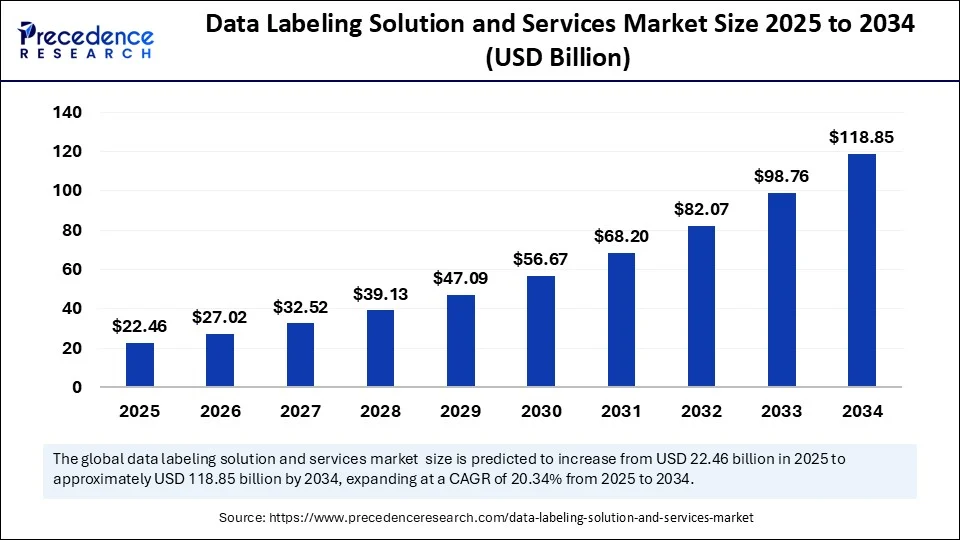
Data Labeling Solution and Services Market Key Takeaways
- In terms of revenue, the global data labeling solution and services market was valued at USD 18.66 billion in 2024.
- It is projected to reach USD 118.85 billion by 2034.
- The market is expected to grow at a CAGR of 20.34% from 2025 to 2034.
- Asia Pacific dominated the data labeling solution and services market with the largest market share of 35% in 2024.
- North America is expected to grow at the fastest rate during the forecast period.
- By sourcing type, the outsourced segment held the biggest market share of 85% in 2024.
- By sourcing type, the in-house segment is expected to grow at the fastest CAGR in the coming years.
- By type, the image/video segment contributed the highest market share of 37% in 2024.
- By type, the audio segment is expected to grow at the fastest CAGR during the forecast period.
- By labeling type, the manual segment captured the major market share of 76% in 2024.
- By labeling type, the automatic segment is expected to register the highest CAGR between 2025 and 2034.
- By vertical, the IT segment generated the largest market share in 2024.
- By vertical, the automotive segment is expected to grow at a significant CAGR in the upcoming period.
How is Artificial Intelligence Transforming the Data Labeling Solution and Services Market?
Artificial intelligence is transforming data labeling through automation, boosting efficiency and accuracy. AI enables automated labeling, semi-supervised learning, and active learning, reducing manual effort. This leads to cost savings, faster turnaround, and improved data quality by minimizing errors and ensuring consistency. AI also enables the development of new services like AI-assisted labeling and specialized solutions. AI tools boost efficiency and accuracy while reducing human effort, making them popular in finance, automotive, and healthcare. This technology increases both accuracy and speed in data labeling.
Asia Pacific Data Labeling Solution and Services Market Size and Growth 2025 to 2034
The Asia Pacific data labeling solution and services market size was exhibited at USD 6.53 billion in 2024 and is projected to be worth around USD 42.19 billion by 2034, growing at a CAGR of 20.51% from 2025 to 2034.
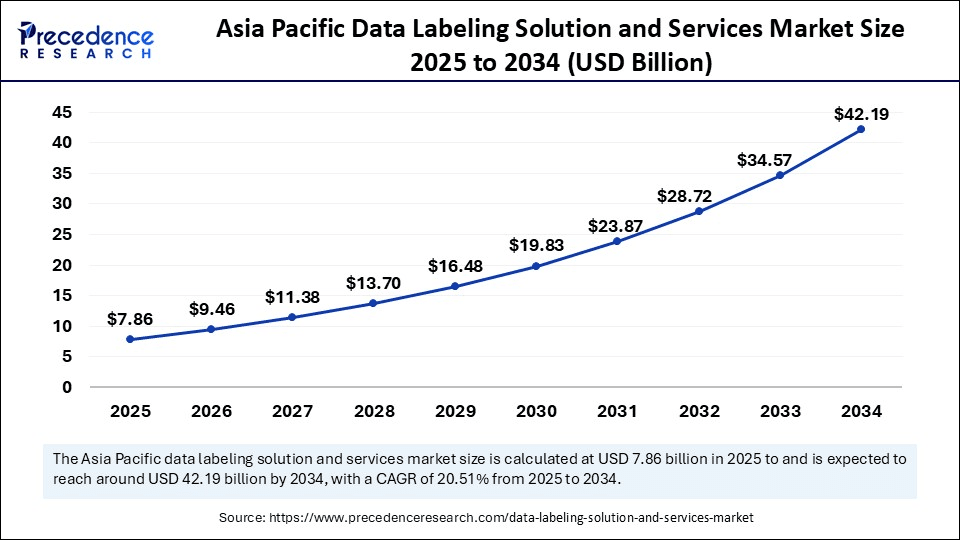
What Factors Contribute to Asia Pacific's Dominance in the Data Labeling Solution and Services Market in 2024?
Asia Pacific dominated the market with the largest share in 2024. This is primarily due to the rapid digitalization and increased adoption of artificial intelligence (AI) and cloud-based solutions across various industries. With the increased digitalization, the volume of data has increased, boosting the need for data labeling solutions. The rapid expansion of the IT sector ensures the long-term growth of the market. Rapid industrialization is also creating a need for specialized data labeling solutions, which in turn supports regional market growth.
China is a significant player in the market. There is a rising use of AI-driven data labels across various industries. These labels act as benchmarks for improving analytical models by utilizing past input and output data. This process provides the necessary foundation to enhance models for tasks like regression and classification, thereby fostering market expansion. India is also emerging as a major player due to the rapid growth of the industrial sector. The Indian government is encouraging the adoption of AI technologies in every industry, supporting market growth.
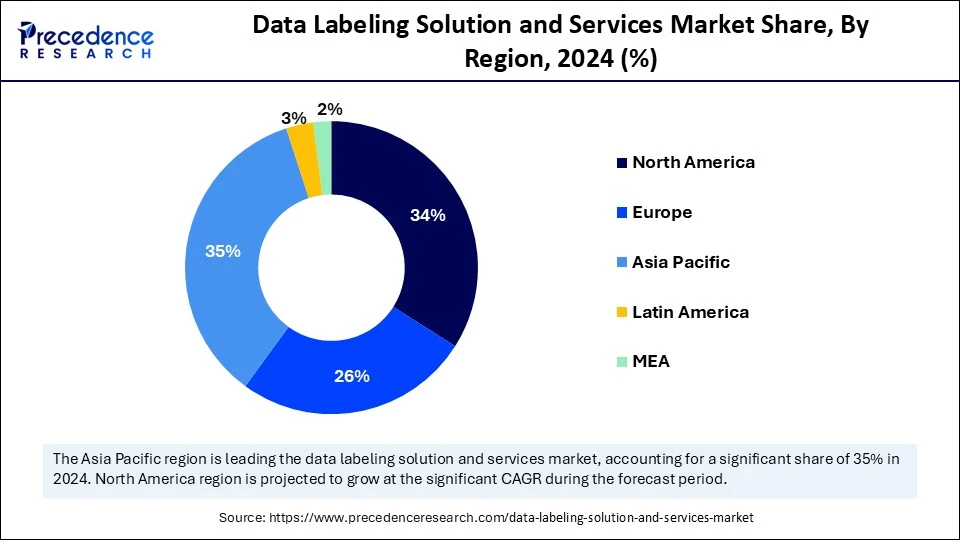
Why is North America Experiencing Fastest Growth in the Data Labeling Solution and Services Market?
North America is expected to experience the fastest growth during the forecast period due to its advanced technological infrastructure and the early adoption of ML and AI technology. There is widespread adoption of AI and ML technologies across industries, boosting the demand for labeled data, as these models require vast datasets for training. The increased volume of data generated from various sources like internet of things (IoT) devices and social media creates the need for efficient data labeling solutions. North America has become a top region for tech start-ups because of the strong presence of tech giants such as Microsoft, Apple, Amazon, Nvidia, Facebook, and Google, which causes the growth of the data labeling solution and services market.
The U.S. is a major player in the market. This is mainly due to the increasing demand for advanced-quality training data to drive the advancement of machine learning (ML) and artificial intelligence (AI) technologies. Data labeling annotates raw data with significant labels, offering context and categorization for machine learning (ML) models to understand. These labels serve as vital guides for ML models, allowing them to interpret data efficiently. There is a high demand for high-quality data and the rising development of advanced data labeling tools, contributing to market growth.
Market Overview
The data labeling solution and services market is experiencing rapid growth, driven by their extensive applications in areas such as Computer Vision, Natural Language Processing (NLP), and Speech Recognition. High-quality data labeling is essential for the performance and reliability of these models, as the labeled data forms the foundation for their training. The primary goal of data labeling solutions is to create a clean, well-structured dataset, enabling AI and machine learning models to learn and make accurate predictions. These solutions streamline the process of assigning labels or tags to raw data, transforming it into a structured format suitable for machine learning algorithms. Data labeling services enhance a model's accuracy and efficiency by providing high-quality, annotated datasets that facilitate pattern recognition and reduce the time required for model training.
What are the Key Factors Boosting the Growth of the Data Labeling Solution and Services Market?
- The rising integration of data labeling solutions with cloud platforms is boosting the growth of the market. Cloud-based labeling platforms provide the advanced infrastructure required for AI model training and execution, supporting sophisticated applications like real-time monitoring and predictive analytics in inventory and labeling management.
- The increasing emphasis on data quality and accuracy to offer advanced data validation and quality control services, boosting the growth of the market.
- Increasing trends toward automated labeling to accelerate data annotation, enhance accuracy, and reduce costs also boosts market growth.
- The rising demand for specialized data labeling services in specific industries, such as healthcare and finance, boosts the growth of the market.
Market Scope
| Report Coverage | Details |
| Market Size by 2034 | USD 118.85 Billion |
| Market Size in 2025 | USD 22.46 Billion |
| Market Size in 2024 | USD 18.66 Billion |
| Market Growth Rate from 2025 to 2034 | CAGR of 20.34% |
| Dominating Region | Asia Pacific |
| Fastest Growing Region | North America |
| Base Year | 2024 |
| Forecast Period | 2025 to 2034 |
| Segments Covered | Sourcing Type, Type, Labeling Type, Vertical, and Region |
| Regions Covered | North America, Europe, Asia-Pacific, Latin America, and Middle East & Africa |
Market Dynamics
Drivers
Increasing Trend of Data Outsourcing
Outsourcing data labeling offers a strategic advantage for major companies by significantly lowering time and operational expenses while improving data quality and providing greater flexibility in labeling options. To ensure high standards of accuracy and consistency, partnering with a reputable and trustworthy data labeling provider is critical. Companies are increasingly outsourcing data labeling tasks to specialized service providers to focus on core business activities and reduce operational costs. Ethical outsourcing requires adherence to data privacy and security protocols, compliance with regulatory requirements, and transparency in vendor engagement, which drives market growth.
Restraint
Challenges Associated with Manual Data Labeling
Manual data labeling, commonly used for generating labeled datasets, creates significant operational constraints in terms of time, scalability, and accuracy. The process is labor-intensive and often demands domain-specific expertise to ensure precise and contextually relevant annotations. In the absence of such specialized knowledge, annotators are challenged in introducing errors, negotiating data quality, and model performance. These limitations make manual labeling a less efficient option, which limits the growth of the data labeling solution and services market.
Opportunity
Advancements in Data Labeling Tools
Advanced data labeling tools create a significant opportunity for organizations to streamline the transformation of raw, unstructured data into structured, machine learning-ready datasets. These specialized platforms not only improve annotation accuracy through intelligent tagging and classification features but also improve workflow efficiency with user-friendly interfaces designed for both technical and non-technical users. Functionality like drag-and-drop tools, keyboard shortcuts, customizable workspaces, and intuitive navigation reduces onboarding time and boosts productivity. Additionally, built-in features for task assignment, progress tracking, and real-time collaboration enable seamless teamwork and operational scalability, positioning data labeling tools as a key to fast-track AI and machine learning initiatives.
Sourcing Type Insights
Why Did the Outsourced Segment Dominate the Market in 2024?
The outsourced segment dominated the data labeling solution and services market with the largest share in 2024, as companies are seeking to reduce operational costs. Outsourcing data labeling provides real estate businesses flexibility and scalability to handle fluctuations in data volume and diverse labeling needs. Outsourcing data labeling presents significant cost advantages compared to sustaining an in-house labeling infrastructure. Outsourcing data labeling speeds up the labeling process, enabling real estate businesses to focus on strategic initiatives and core operations.
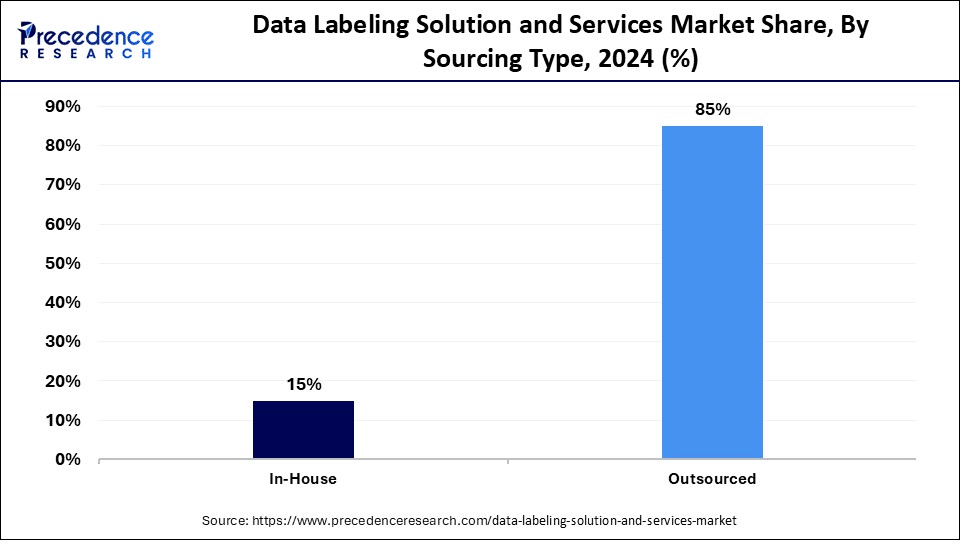
The in-house segment is expected to experience significant growth in the upcoming period, as an in-house method of data labeling provides many advantages, including the development of consistent labeling procedures, a replicable system for managing data, and a feedback loop that continually fosters best practices in the aggregation of data. In-house labeling is advantageous when exceptional domain knowledge is required.
Type Insights
What Made Image/Video the Dominant Segment in the Market in 2024?
The image/video segment dominated the data labeling solution and services market with the biggest share in 2024. This is mainly due to the increased volume of visual data generated from various sources, such as social media and business operations, necessitating efficient data labeling solutions. Image labeling is the procedure of detecting and tagging particular details in an image, often used to build datasets for training computer vision algorithms. It involves interpreting images, either manually or with the support of an automated device, to designate what's in the image, like boundaries, objects, or key points. Image annotation and labeling support businesses to in performing particular tasks to enhance tracking, product discoverability, security, and sales.
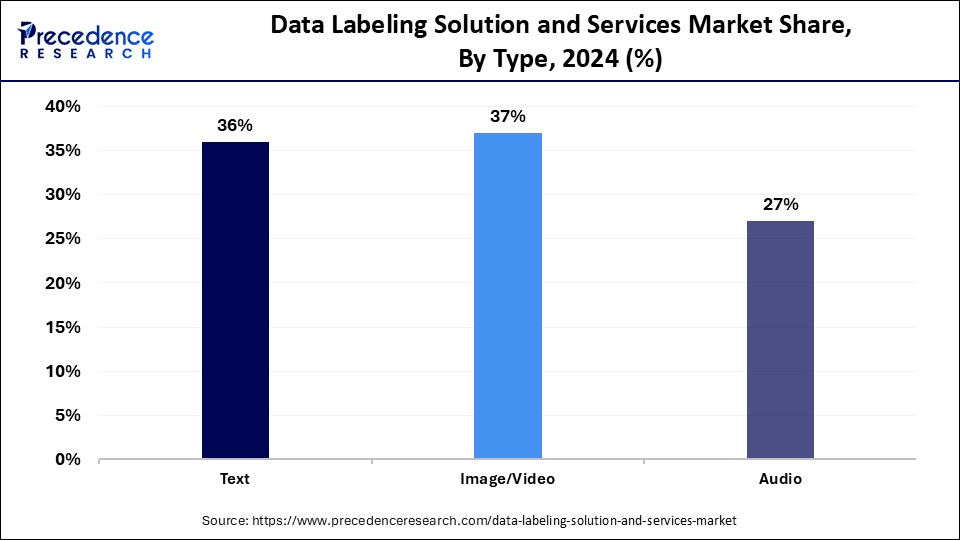
The audio segment is expected to grow at the fastest CAGR over the forecast period, driven by the rising adoption of speech recognition and voice-activated systems among businesses to enhance customer experience. By precisely labeling and analyzing audio data, industries gain a deeper understanding of their consumer sentiments, needs, and preferences, which can lead to a better customer experience. This information is used to make up-to-date decisions, enhance services or products, and improve customer satisfaction. Audio labeling is used for a variety of purposes, like improving searchability, organizing audio files, and making it easier to find particular parts of an audio recording.
Labeling Type Insights
How Does the Manual Segment Dominate the Market in 2024?
The manual segment held the largest share in the data labeling solution and services market in 2024, as it offers many benefits, such as providing better flexibility, accuracy, and quality control, while also being affordable. By selecting manual data labeling, organizations and businesses can ensure that their machine learning models are trained with better-quality data, leading to improved performance and outcomes. Furthermore, following ideal practices for physical data labeling further enhances the efficiency and accuracy of the process. Manual data labeling is an ideal choice for those seeking to progress their machine learning abilities.
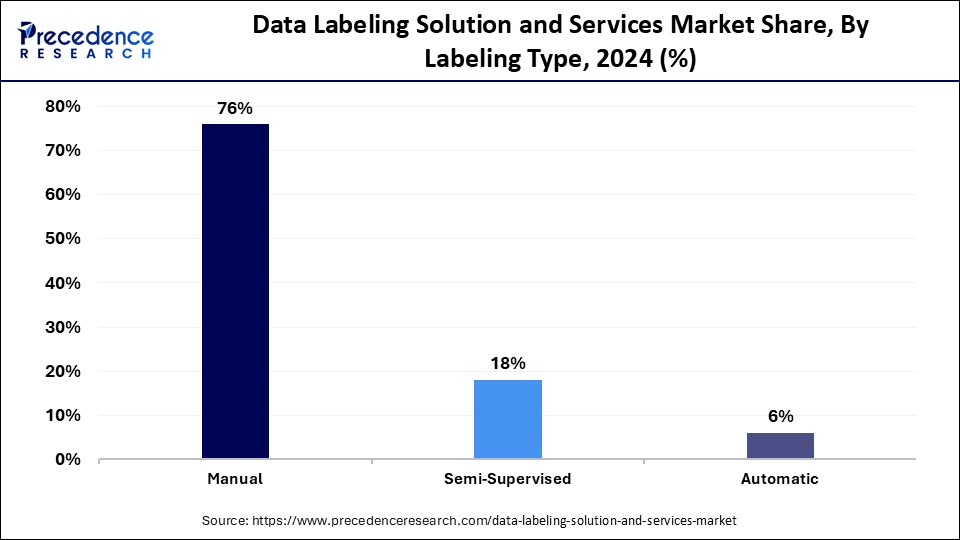
The automatic segment is expected to expand at the fastest CAGR during the projection period due to the increasing need to optimize workflow. Automatic data labeling creates an efficient and precise option. It offers faster data processing speeds, improved accuracy, and reduced expenses in comparison to the physical labeling process. Automatic data labeling is predominantly advantageous for large-scale developments and cases where accuracy is of utmost importance.
Vertical Insights
What Made IT the Dominant Segment in the Data Labeling Solution and Services Market in 2024?
The IT segment dominated the market with a major revenue share in 2024. This is mainly due to the increased adoption of AI and ML technologies in the IT industry, generating massive amounts of unstructured and structured data. The accuracy and performance of AI and ML models depend heavily on the quality of the training data. This drives the need for precise and reliable data labeling services. There is a heightened need for accurate labeling to train generative AI models for tasks like data mining, predictive analytics, and cyber security, bolstering the growth of the segment.
The automotive segment is expected to grow at the highest CAGR during the forecast period. The growth of the segment is attributed to the rising development of autonomous vehicles and the increasing adoption of ADAS. Data labeling is revolutionizing the automotive sector, enhancing the safety of autonomous vehicles, and enhancing machine learning models. Precise data labeling confirms that machine learning models appropriately interpret the environment, leading to reliable and safer autonomous driving experiences.
Data Labeling Solution and Services Market Companies
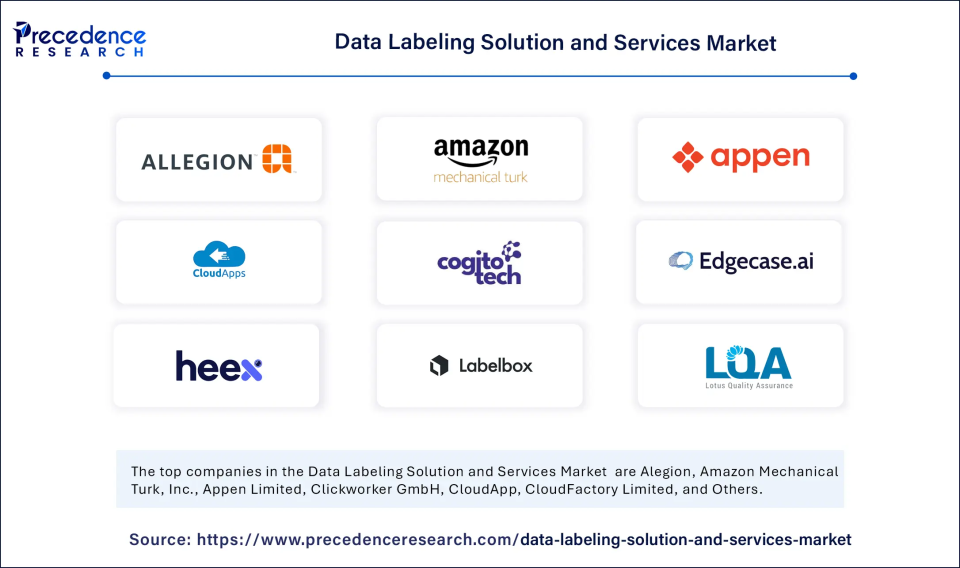
- Alegion
- Amazon Mechanical Turk, Inc.
- Appen Limited
- Clickworker GmbH
- CloudApp
- CloudFactory Limited
- Cogito Tech LLC
- Deep Systems, LLC
- edgecase.ai
- Explosion AI GmbH
- Heex Technologies
- Labelbox, Inc.
- Lotus Quality Assurance
- Mighty AI, Inc.
- Playment Inc.
- Scale AI
- Shaip
- Steldia Services Ltd.
- Tagtog Sp. z o.o.
- Trilldata Technologies Pvt Ltd
- Yandez LLC
Recent Developments
- In February 2025, Palantir partnered with a data-labeling startup to improve the accuracy of AI models used by the Department and Intelligence Community. Under the agreement, federal customers using Palantir's Foundry system, a software-based data analytics platform that leverages AI and machine learning to automate decision-making can request data labeling services from Enabled Intelligence.
(Source: https://defensescoop.com) - In October 2024, transcosmos announced that the company has developed “trans-AI Annotator,” its proprietary AI data labelling solution in South Korea. The solution automates data labelling tasks by performing image and text analysis with the power of AI.
(Source: https://www.trans-cosmos.co.jp)
Segments Covered in the Report
By Sourcing Type
- In-House
- Outsourced
By Type
- Text
- Image/Video
- Audio
By Labeling Type
- Manual
- Semi-Supervised
- Automatic
By Vertical
- IT
- Automotive
- Government
- Healthcare
- Financial Services
- Retails
- Others
By Region
- North America
- Europe
- Asia Pacific
- Middle East & Africa
- Latin America